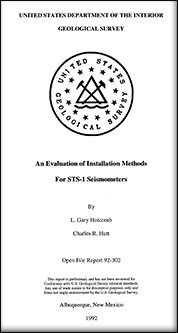An evaluation of installation methods for STS-1 seismometers
Links
- Document: Report (1819 pdf)
- Download citation as: RIS | Dublin Core
Abstract
This report documents the results of a series of experiments conducted by the authors at the Albuquerque Seismological Laboratory (ASl) during the spring and summer of 1991; the object of these experiments was to obtain and document quantitative performance comparisons of three methods of installing STS-1 seismometers.
Historically, ASL has installed STS-1 sensors by cementing their thick glass base plates to the concrete floor of the vault (see Peterson and Tilgner, 1985, p 44 and Figure 31, p 51 for the details of this installation technique). This installation technique proved to be fairly satisfactory for the China Digital Seismic Network and for several sets of STS-1 sensors installed in other locations since that time. However, the cementing operation is rather labor intensive and the concrete requires a lengthy (about 1 week) curing time during which the sensor installed on it is noisy. In addition it is difficult to assure that all air bubbles have been removed from the interface between the cement and the glass base plate. If air bubbles are present beneath the plate, horizontal sensors can be unacceptably noisy. Moving a sensor installed in this manner requires the purchase of a new glass base plate because the old plate normally can not be removed without breakage.
Therefore, this study was undertaken with the aim of developing an improved method of installing STS-1's. The goals were to develop a method which requires less field site labor during the installation and assures a higher quality installation when finished. In addition, the improved installation technique should promote portability.
Two alternate installation techniques were evaluated in this study. One method replaces the cement between the base plate and the vault floor with sand. This method has been used in the French Geoscope program and in several IRIS/IDA installations made by the University of California at San Diego (UCSD) and possibly others. It is easily implemented in the field and is quite cheap. The other method utilizes a so called warpless housing designed by E. Wielandt and implemented at ASL. This housing is quite similar to the case design of the STS-2 sensor system. It is designed to minimize the effects of atmospheric pressure variations on the sealed housing.
| Publication type | Report |
|---|---|
| Publication Subtype | USGS Numbered Series |
| Title | An evaluation of installation methods for STS-1 seismometers |
| Series title | Open-File Report |
| Series number | 92-302 |
| DOI | 10.3133/ofr92302 |
| Year Published | 1992 |
| Language | English |
| Publisher | U.S. Geological Survey |
| Contributing office(s) | Albuquerque Seismological Laboratory |
| Description | 37 p. |


